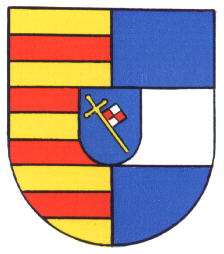Ilmspan: Difference between revisions
Knorrepoes (talk | contribs) m (Text replacement - ".jpg|center]]" to ".jpg|center|Wappen von {{PAGENAME}}]]") |
Knorrepoes (talk | contribs) m (Text replacement - " :" to ":") Tags: Mobile edit Mobile web edit |
||
| (22 intermediate revisions by the same user not shown) | |||
| Line 1: | Line 1: | ||
'''ILMSPAN''' | '''ILMSPAN''' | ||
State : [[Baden-Württemberg]]<br/> | State: [[Baden-Württemberg]]<br/> | ||
District (Kreis) : [[Main-Tauber Kreis]] (until 1973 [[Tauberbischofsheim (kreis)|Tauberbischofsheim]])<br/> | District (Kreis): [[Main-Tauber Kreis]] (until 1973 [[Tauberbischofsheim (kreis)|Tauberbischofsheim]])<br/> | ||
Incorporated into : 1972 [[Großrinderfeld ]]<br/> | Incorporated into: 1972 [[Großrinderfeld ]]<br/> | ||
[[File:ilmspan.jpg|center|Wappen von {{PAGENAME}}]] | [[File:ilmspan.jpg|center|alt=Wappen von {{PAGENAME}}/Arms (crest) of {{PAGENAME}}]] | ||
= | {| class="wikitable" | ||
In gespaltenem Schild vorne in Gold vier rote Balken, hinten in Blau ein silberner Balken, im blauen Herzschild eine von Rot und Silber gevierte Fahne an schräggestelltem goldenem Kreuzstab. | |+Official blazon | ||
|- | |||
|'''German''' | |||
| In gespaltenem Schild vorne in Gold vier rote Balken, hinten in Blau ein silberner Balken, im blauen Herzschild eine von Rot und Silber gevierte Fahne an schräggestelltem goldenem Kreuzstab. | |||
|- | |||
|'''English''' | |||
| blazon wanted | |||
|} | |||
===Origin/meaning=== | |||
The arms were adopted in 1896. | The arms were adopted in 1896. | ||
Ilmspan did not have its own arms before 1896, the local seal only showed the name of the village. In 1895 the local council applied at the State Archives for new arms. The Archives proposed the above arms, which combine the arms of the Counts of Rieneck (red/golden bars) and Leuchtenburg (blue/silver), with the banner of the State of Würzburg. Ilmspan historically belonged to the Archbishops of Würzburg, who gave it in loan first to the Counts of Rieneck and later to the Counts of Leuchtenberg. | Ilmspan did not have its own arms before 1896, the local seal only showed the name of the village. In 1895 the local council applied at the State Archives for new arms. The Archives proposed the above arms, which combine the arms of the Counts of Rieneck (red/golden bars) and Leuchtenburg (blue/silver), with the banner of the State of Würzburg. Ilmspan historically belonged to the Archbishops of Würzburg, who gave it in loan first to the Counts of Rieneck and later to the Counts of Leuchtenberg. | ||
{{de}} | |||
{{media}} | {{media}} | ||
[[Literature]] : Zier and Kastner, 1967 | [[Civic Heraldry Literature - Germany|'''Literature''']]: Zier and Kastner, 1967 | ||
[[Category:German Municipalities I]] | [[Category:German Municipalities I]] | ||
Latest revision as of 11:12, 11 August 2024
ILMSPAN
State: Baden-Württemberg
District (Kreis): Main-Tauber Kreis (until 1973 Tauberbischofsheim)
Incorporated into: 1972 Großrinderfeld
| German | In gespaltenem Schild vorne in Gold vier rote Balken, hinten in Blau ein silberner Balken, im blauen Herzschild eine von Rot und Silber gevierte Fahne an schräggestelltem goldenem Kreuzstab. |
| English | blazon wanted |
Origin/meaning
The arms were adopted in 1896.
Ilmspan did not have its own arms before 1896, the local seal only showed the name of the village. In 1895 the local council applied at the State Archives for new arms. The Archives proposed the above arms, which combine the arms of the Counts of Rieneck (red/golden bars) and Leuchtenburg (blue/silver), with the banner of the State of Würzburg. Ilmspan historically belonged to the Archbishops of Würzburg, who gave it in loan first to the Counts of Rieneck and later to the Counts of Leuchtenberg.
This page is part of the German heraldry portal Deutsche Wappensammlung |
Heraldry of the World |
|
German heraldry:
|
Selected collector's items from Germany:
|
Contact and Support
Partners:
Your logo here ?
Contact us
© since 1995, Heraldry of the World, Ralf Hartemink 
Index of the site
Literature: Zier and Kastner, 1967












